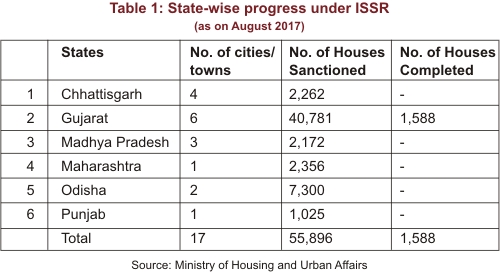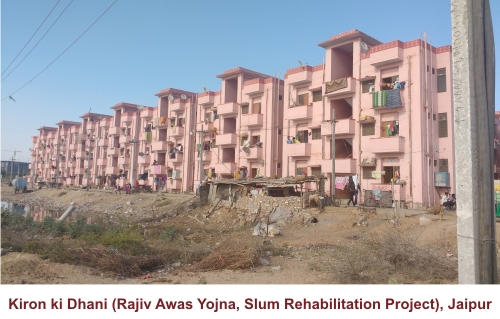SDGs and Housing for Urban Poor – The Way Forward
Sustainable Development Goals (SDGs) are a set of 17 Global Goals with 169 targets between them covering a broad range of sustainable development issues to be achieved by 2030. These 17 goals came into effect in January, 2016. The 11th goal deals with Sustainable Cities and Communities - Make cities and human settlements inclusive, safe, resilient and sustainable. The first target under this Goal is to ensure access to adequate, safe and affordable housing and basic services for all and upgrade slums by 2030. The slum households have been defined as those that lack one or more of the following: durable housing, sufficient living space, easy access to safe water, access to adequate sanitation and security of tenure.
As per the 2011 census, 13.75 million households accounting for 17 per cent of India's urban population lived in slums. The mega cities of Greater Mumbai, Delhi NCR and Kolkata house about 42 to 55 per cent of their population in slums, whereas the proportion of slum dwellers and urban poor in the million-plus cities in the country is around 35 per cent (India Habitat III – National Report 2016).
In the last one decade, Government of India has formulated three different housing schemes for the urban poor namely, Jawaharlal Nehru National Urban Renewal Mission (JNNURM) which was launched in 2005, Rajiv Awas Yojana (RAY) in 2013 and the most recent being the Pradhan Mantri Awaas Yojana (PMAY) – Housing for All (Urban). The scheme was launched in June 2015 with the objective of addressing the housing requirement of urban poor including slum dwellers to be implemented through four verticals:
a) In situ Slum Redevelopment,
b) Affordable Housing through Credit Linked Subsidy,
c) Affordable Housing in Partnership and
d) Subsidy for Beneficiary-Led Individual House Construction or Enhancement.
The scheme with all its components has become effective from the date 17.06.2015 and will be implemented up to 31 March 2022. All statutory towns as per Census 2011 and towns notified subsequently would be eligible for coverage under the scheme.
Out of the four verticals, In situ Slum
Redevelopment (ISSR) using land as a resource with private participation for
providing houses to eligible slum dwellers is an important vertical
addressing the issues of housing for the slum dwellers. The ISSR aims to
leverage the locked potential of land under slums to provide houses to the
eligible slum dwellers thereby bringing them into the formal urban
settlement. Under this vertical, slums, whether on government land or on
private land would be taken up for in-situ redevelopment. The private
partner for slum redevelopment would be provided additional Floor Area Ratio
(FAR)/Floor Space Index (FSI)/Transferable Development Rights (TDR) for
making the slum redevelopment projects financially viable.
Two year have passed since the since the launch of this scheme. Let us examine the progress under the In-site Slum Redevelopment vertical of the PMAY. As per the latest available information, 17 cities/towns in 6 states (Chhattisgarh, Gujarat, Madhya Pradesh, Maharashtra, Odisha, and Punjab) were covered for funding under In situ Slum Redevelopment (ISSR). Large metropolitan cities like Mumbai, Delhi and Kolkata having sizeable slum population did not take up any project under this vertical. As on end August 2017, out of the total 24,18,547 houses sanctioned under PMAY, only 2.31 per cent (or 55,896 houses) were sanctioned under ISSR and construction of 1588 houses (or 2.84 per cent of the sanctioned houses) was completed. At present, none of the constructed houses are occupied. Table 1 presents the state wise progress under ISSR. From the table, one can see that 6 out of 17 cities considered for funding under ISSR are in Gujarat. Gujarat also accounts for the most number of houses sanctioned (72.96 per cent of the total houses sanctioned under ISSR). All the houses that were constructed under this vertical are in Gujarat and not a single house has been occupied.
The progress under In situ Slum Redevelopment vertical has been rather slow. Only 6 states have taken up this vertical for providing housing to slum dwellers. Despite being a workable model, which not only benefits the slum dwellers as they are provided formal housing without disturbing their existing setup, but also the private developers as they are allowed to sell the flats constructed with additional FSI/FAR/TDR in the open market. In the whole process, government is able to leverage the land locked under slums for formal housing without spending any money in the project.
Despite being beneficial to all the stakeholders
– slum dwellers, private developers, land owners and government, why are
there no takers for this vertical? Some of the reasons for the slow progress
of the scheme are: The scheme does not specify how much additional FSI/FAR/TDR
that would be provided to private developers or to the land owner and leaves
it to state governments to decide. Eligibility of the slum dwellers like
cut-off date etc. will also be decided by the states. States have not been
able to work out all these details as a result there is no clarity to the
private developer or land owner as regards the remunerative component under
this vertical. Moreover, the requirement that project developers would have
to provide for the transit accommodation to the eligible slum dwellers
during the construction period is a disincentive for private players
 to
participate in this vertical.
to
participate in this vertical.
In Delhi, as per 2011 census, there are around 685 Jhuggi-Jhompri (JJ) clusters with a population of 25,18,191 spread in an area of 700 hectares. So far, no project for has been taken up in Delhi under ISSR. Under Basic Services for Urban Poor (BSUP) which is a sub-mission under Jawaharlal Nehru Urban Renewal Mission (JNNURM), number of houses were constructed for housing the slum dwellers in Delhi. The total number of sanctioned dwellings in Delhi under BSUP were 71,884 out of which 31,484 dwellings were completed. Most of the dwellings were located in North-west and South-west Delhi. Only 6,532 of the constructed dwellings were occupied while the remaining 79 percent were lying vacant. The main reason for this is that Delhi Government is not able to fix the cut-off date for deciding the eligibility for allotting the flats. Under the Rajiv Awaas Yojana, no project has been initiated in Delhi although a total of 1,17,707 dwellings units were sanctioned in other states in the country. 31.2 percent of the sanctioned units were completed and around 52.6 percent of the completed units are vacant.
Thus, we see that policies of the Government of India aimed at addressing the housing needs of the poor have not been successful. Although a number of dwellings were constructed under JNNURM, most of them are lying vacant. Under RAY also no project has been initiated in Delhi. As regards PMAY-Urban we find that in the last two years since the scheme has been launched, no project has been taken-up under the vertical In-situ Slum Redevelopment.
It is time we review our policies for the urban poor and ensure that their benefits reach the targeted groups so that the target of ensuring access to adequate, safe and affordable housing and basic services for all and upgradation of slums is achieved by 2030. ■
Ruchita Gupta
Assistant Professor
Department of Housing, School
of Planning and Architecture
New Delhi
ruchita.garg@gmail.com